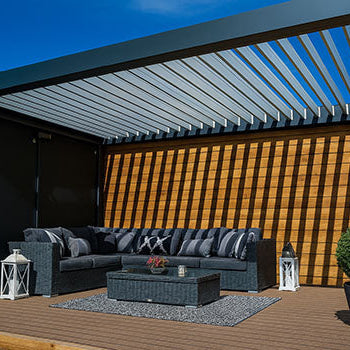Think your fence is safe… until Bob from next door bolts up pergolas, planters, and, why not a dartboard, right on your side.
Short answer? No, your neighbour can’t legally attach anything to your fence without your clear permission.
But the full story is more than just a yes or no. Fence ownership, shared responsibilities, and planning rules can get murky. So before things turn passive-aggressive over the garden hedge, here’s everything you need to know.

The First Question: Who Owns the Fence?
This is where most neighbourly confusion starts. If you don’t know who owns the fence, you can’t really say what can or can’t be done with it.
Let’s clear that up first.
How to Check Your Title Deeds and Property Plans
Your title deeds and land registry documents are the starting point. These aren’t just dusty papers, they’re your proof.
Pull them out and look for diagrams or plans that outline the boundary lines. They usually show which side of the property each boundary belongs to. If you're not sure how to read them, a solicitor or conveyancer can help make sense of it.
Understanding T-Marks on a Plan
Ever spotted a tiny “T” on a boundary line in those plans? That’s not a typo, it’s a T-mark, and it’s important.
A “T” pointing towards your land usually means you’re responsible for that side of the fence. If there’s a mirrored “T” on both sides (sometimes shown as an “H”), it could mean the fence is jointly owned, making it a party fence.
What if it's a Shared "Party Fence"?
In a shared situation, neither you nor your neighbour can just start drilling, painting, or attaching things without the other’s okay.
Shared fences need shared decisions. That means no solo decorating projects, especially ones that involve nails, screws, or pergola supports.
The Legal Presumption if Ownership is Unclear
Can’t find a “T”? No clear owner in the deeds? The legal presumption is that the fence on the left belongs to the property on the left (as seen from the road).
But be warned, that’s not a guarantee. It’s more of a default guess if there’s no better evidence. Always better to check than to assume.
If You Own the Fence: Your Rights and Their Responsibilities
So, you've confirmed the fence is yours. That changes things. It also gives you control over what happens to it, and what doesn't.
The Simple Answer: They Need Your Explicit Permission
Can my neighbour attach things to my side of the fence?
Not without your say-so. Even if it’s “just a flower basket” or “a few fairy lights,” attaching anything to your property without permission is legally off-limits.
Why Attaching Anything Constitutes Trespass
This isn’t just about manners, it’s about law. Attaching items to your fence without consent is trespassing.
It may not seem serious, but it’s a violation of your property rights. Whether it's a hanging lantern or a pergola beam leaning on your fence, it's crossing the legal line.
The Risk of Damage and Your Right to Have it Removed
Let’s say your neighbour mounts something heavy and your fence starts leaning or splitting. That’s not your problem, it’s theirs.
You’re entitled to ask them to remove it and pay for repairs. If they refuse, you may have legal grounds to take action.
Your Liability for Any Injury Caused by Their Attachments
Here's where it gets tricky. If their planter falls and injures someone on your property, or even a delivery driver, you could be held legally responsible just because it’s on your fence.
Even though you didn’t put it there. Scary, right? That’s why it’s so important to keep control of what gets attached to your property.

What Can Your Neighbour Attach to Their Side of the Fence?
Let’s flip things around. Can your neighbour use their side of the fence how they like?
Well, it depends on who owns it.
Their Right to Use Their Side of a Fence They Own
If your neighbour owns the fence, they’re generally allowed to decorate, hang planters, or even paint their side. As long as it doesn’t damage the structure or spill over into your space, that’s their call.
But even then, being neighbourly is still important. No one likes a surprise burst of orange paint in their garden view.
Considerations for a Shared Party Fence
With a shared fence, both sides must be considered. Your neighbour shouldn’t attach anything, even on their side, without talking to you first.
Why? Because shared fences carry shared responsibilities. Any change that affects the strength or look of the structure needs joint approval.
The Impact of Heavy Items on the Fence's Stability
Let’s talk weight. Heavy flower boxes, wall art, or mounted shelves might seem harmless, but they can warp or weaken the fence over time.
Even if those items are on their side, if they compromise the fence’s structure, you’ve got every right to speak up.
Practical Steps for Dealing with Unwanted Attachments
You’ve spotted mystery hooks or a pergola bracket drilled into your fence. Now what?
Let’s break down your next steps, without escalating things too quickly.
Step 1: A Polite Conversation is Always the Best Start
Start simple: talk to them.
Sometimes people don’t realise it’s an issue, and a calm conversation is all it takes. Let them know you’ve noticed the attachments and that they weren’t agreed upon. Ask kindly if they could be removed.
Real talk: this works most of the time.
Step 2: Putting Your Request in Writing (A Friendly Letter)
If the polite chat didn’t land, a short letter can help. Keep it light but clear. State that you’ve spoken to them, remind them it’s your fence, and formally ask for the items to be removed.
Written records matter. If things escalate, this letter shows you tried to resolve things peacefully.
Step 3: What to Include in a Formal Letter from a Solicitor
Still no luck? It might be time to bring in a solicitor. A formal letter should include:
-
Proof or confirmation of ownership
-
A request to remove the attachments
-
Mention of potential legal action if the situation continues
A letter from a solicitor often gets faster results than any amount of polite knocking.
Can You Legally Remove the Items Yourself? (The Risks Involved)
Technically, you can remove things from your own property, but it’s risky.
If you damage something that belongs to your neighbour (even if they shouldn't have put it there), you could be liable. Best to give notice first and consider getting legal advice before pulling things off yourself.

Frequently Asked Questions About Fence Etiquette
Still unsure about the fence rules? Here are quick answers to the most common questions homeowners ask.
Can my neighbour paint or stain my side of the fence?
No, only with your permission. It’s your fence, and painting it without asking is legally considered trespassing, no matter how trendy the colour is.
Can they hang plants or a trellis on my fence?
Not without your approval. Even small things can lead to damage or disputes. Always talk it through first.
My neighbour's attachments have damaged my fence, what can I do?
Ask them to remove the items and pay for repairs. If they refuse, gather evidence, get a quote for repairs, and consider legal advice. Small claims court is an option if the cost is reasonable.
Final Word
In the world of garden boundaries, a little knowledge (and a lot of communication) goes a long way. Know who owns what, don’t let things slide, and if in doubt. Talk first, escalate later.









